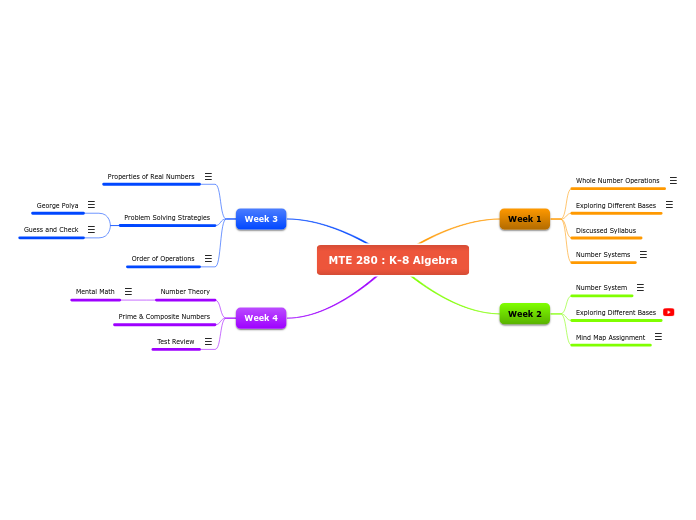MTE 280 : K-8 Algebra
Week 4
Test Review
Discussed studying for test and study guide.
Prime & Composite Numbers
Number Theory
Mental Math
Mental Addition
- Left - To - Right - add 347 and 129, we first add the hundreds (300 + 100) then the tens (40 + 20), and then the ones (7+9), to obtain 476.
- Compensation - find the sum 67 + 29, we add 67 + 30 (since 30 is the next multiple of 10 greater than 29) to obtain 97 and then we subtract 1 from 97 to compensate for the extra 1 that was added to obtain 97 − 1 = 96.
- Using Compatible Numbers - find the sum 130 + 50 + 70 + 20 + 50 we will add first the numbers 130 and 70 to obtain 200, the numbers 50 and 50 to obtain 100, then the numbers 200 and 100 to obtain 300 and finally we add 20 to 300 to obtain 320.
- Breaking Up and Bridging - find the sum 67 + 36 we find first the sum 67 + 30 = 97 and then the sum 97 + 6 = 103.
Mental Subtraction
- Left - To - Right - find the difference 93 − 38 we find first 90 − 30 = 60, then 8 − 3 = 5 and finally 60 − 5 = 55. To find the difference, 47 − 32, we find first 40 − 30 = 10, then 7 − 2 = 5 and finally 10 + 5 = 15.
- Breaking Up and Bridging - find the difference 67 − 36 we first find 67 − 30 = 37 and then 37 − 6 = 31.
- Compensation - 47−29 is the same as finding 48−30 = 18. That is we add the same number to both addends. This is known as the equal addition method for subtraction.
- Drop the Zeros - find 8700 − 500 we find 87 − 5 = 82 and then add the two zeros to the right of 82 to obtain 8200.
- Compatible Numbers - find the difference 170 − 50 − 30 − 50 we can find first 170 − 30 = 140, then 50 + 50 = 100 and finally 140 − 100 = 40.
Mental Multiplication
- Compatible Numbers - find the product 2 × 9 × 5 × 20 × 5 we can rearrange the product in the form 9×(2×5)×(20×5) = 9×10×100 = 9000.
- Left - to - Right - find the product 3 × 123 we can look at it as the expression 3 × 100 + 3 × 20 + 3 × 3 = 369.
- Multiplying Powers of 10 - find the product 12, 000 × 110, 000 we multiply the numbers 12 × 11 = 132 and then add 7 zeros to the right to obtain 1,320,000,000.
Mental Division
- Compatible Numbers - find 105 ÷ 3 we look for two numbers that are divisible by 3 and whose sum is 105, namely, 90 and 15. We then divide both numbers by 3 to obtain 90 ÷ 3 = 30 and 15 ÷ 3 = 5. Finally add the quotients to obtain 105 ÷ 3 = 30 + 5 = 35.
Week 3
Order of Operations
- Worked in groups of 4 on a worksheet with a technique called "Recall"
Order of Operations - following the rules
P.E.M.D.A.S
Parentheses
Exponents
Multiplication
Division
Addition
Subtraction
Problem Solving Strategies
Guess and Check
Guess and Check is always an effective way to problem solve.
George Polya
George Polya was one of the most famous mathematics educators of the 20th century. Dr. Polya strongly believed that the skill of problem solving could and should be taught – it is not
something that you are born with.
Four principles of problem solving:
- Understand The Problem
- Devise A Plan
- Carry Out The Plan
- Look Back (Reflect)
Properties of Real Numbers
Learned about different properties:
- Commutative Property of Addition: a + b=b + a
- Commutative Property of Multiplication: a × b = b × a
- Associative Property of Addition: (a + b) + c = a = (b + c)
- Associative Property of Multiplication: (a × b) × c = a × (b × c)
- Identity Property of Addition: a + 0 = a
- Identity Property of Multiplication: a × 1 = a
- Inverse Property of Addition: For every a, there is an additive inverse -a such that a +(-a)=0
- Inverse Property of Multiplication: For every a (a ≠ 0), there is a multiplicative inverse 1/a such that a(1/a) = 1.
- Distributive Property: a (b + c) = ab + ac
- Multiplication Property of Zero: For every real number n, n × 0 = 0.
- Multiplication Property of -1: For every real number n, -1 × n = -n.
Week 2
Mind Map Assignment
- Began to discuss more about Mind Map assignment and what will be expected on it.
(I joined class at the end of this week, so I missed everything up until here and going off of the slides.)
Number System
- Packet assigned covering everything that we have covered in class with Whole Numbers, Exploring Different Bases, and Number Systems.
- Binary and Mayan more in depth in packet with groups.
Week 1
Number Systems
- Place value: assigns a value toa digit depending on its placement in a numeral order.
Mayan Numeration System - Packet that was submitted
Binary Numeration System - Packet that was submitted
Roman Numeration System - From slides
Discussed Syllabus
Exploring Different Bases
- Exploring Base Ten Blocks - Working with manipulatives of unit, long, flat, and cube
- Exploring Base Two Blocks - Important in computers
- Exploring Base Twelve Blocks - From slides
Whole Number Operations
- Briefly discussed Expanded Form and applying it to other equations

